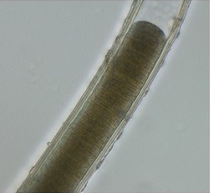Moorea producens
Topic: Biology
 From HandWiki - Reading time: 2 min
From HandWiki - Reading time: 2 min

| Moorea producens | |
|---|---|
| Scientific classification | |
| Domain: | Bacteria |
| Phylum: | Cyanobacteria |
| Class: | Cyanophyceae |
| Order: | Oscillatoriales |
| Family: | Oscillatoriaceae |
| Genus: | Moorea |
| Species: | M. producens
|
| Binomial name | |
| Moorea producens Engene, Rottacker, Kastovsky, Byrum, Choi, Ellisman, Komárek & Gerwick, 2012
| |
Moorea producens is a species of filamentous cyanobacteria in the genus Moorea, including tropical marine strains formerly classified as Lyngbya majuscula[1] due to morphological resemblance but separated based on genetic evidence.[2] Moorea producens grows on seagrass [3] and is one of the causes of the human skin irritation seaweed dermatitis.[4] It is known as fireweed in Australia [5] and stinging limu in Hawaii.[6]
The prevalence of this organism appears to be on the increase due to pollution and overfishing. Nutrients such as nitrogen and human waste flow to the ocean due to rain and sewage runoff; these added nutrients increase the population of microbes, which in turn remove oxygen from the water. Reduced numbers of fish to eat the microbes further enhances the microbe populations. Cyanobacteria are evolutionarily optimized for environmental conditions of low oxygen.[7] M. producta is non-diazotrophic.[2]
M. producens is known for its toxicity, producing Lyngbyatoxin-a and other "antifungal and cytotoxic agents, including laxaphycin A and B and curacin A."[8]
A major outbreak occurred in Darwin Harbour in May- June 2010.
References
- ↑ Espinel Nadjejda (2005-07-26). "Lyngbya majuscula Harvey in Hooker ex Gomont, 1892". MarineSpecies.org. http://www.marinespecies.org/aphia.php?p=taxdetails&id=177509.
- ↑ 2.0 2.1 "Moorea producens gen. nov., sp. nov. and Moorea bouillonii comb. nov., tropical marine cyanobacteria rich in bioactive secondary metabolites". Int. J. Syst. Evol. Microbiol. 62 (Pt 5): 1171–1178. 2012. doi:10.1099/ijs.0.033761-0. PMID 21724952.
- ↑ "Lyngbya Management Strategy". Archived from the original on 2009-03-26. https://web.archive.org/web/20090326054446/http://www.epa.qld.gov.au/environmental_management/coast_and_oceans/marine_habitats/lyngbya_management_strategy.
- ↑ "Seaweed dermatitis". New Zealand Dermatological Society. 2007-02-24. http://www.dermnetnz.org/dermatitis/plants/seaweed.html.
- ↑ "Fireweed Fears Hosed Down". University of Queensland. 2005. Archived from the original on 2007-03-10. https://web.archive.org/web/20070310160156/http://www.uq.edu.au/research/index.html?page=37163&pid=37143.
- ↑ "Stinging Limu -- Seaweed". http://www.aloha.com/%7Elifeguards/limu.html.
- ↑ Kenneth R. Weiss (2006-07-30). "A Primeval Tide of Toxins". Los Angeles Times. http://www.latimes.com/news/local/oceans/la-me-ocean30jul30,0,6670018,full.story.
- ↑ A. M. Burja; E. Abou-Mansour; B. Banaigs; C. Payri; J. G. Burgess; P. C. Wright (2002). "Culture of the marine cyanobacterium, Lyngbya majuscula (Oscillatoriaceae), for bioprocess intensified production of cyclic and linear lipopeptides". Journal of Microbiological Methods 48 (2–3): 207–219. doi:10.1016/S0167-7012(01)00324-4. PMID 11777570.
Further reading
- "Lyngbya". Protist Information Server. http://protist.i.hosei.ac.jp/PDB/Images/Prokaryotes/Oscillatoriaceae/Lyngbya/.
- Nicholas John Osborne (2004). Investigation of the toxicology and public health aspects of the marine cyanobacterium, Lyngbya majuscula. Ph.D. thesis, University of Queensland. p. 246 pp. http://www.library.uq.edu.au/pdfserve.php?image=thesisabs/absthe18107.pdf.
Wikidata ☰ Q293131 entry
 |
 KSF
KSF